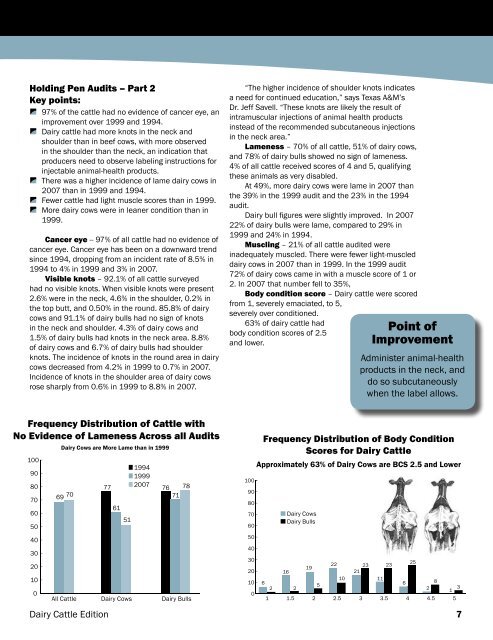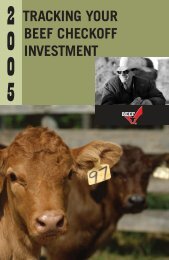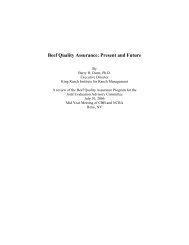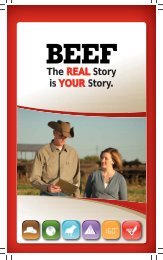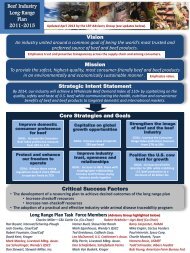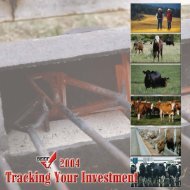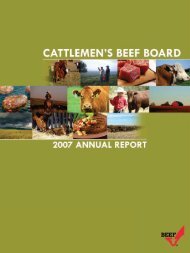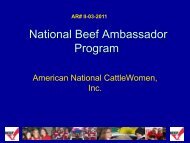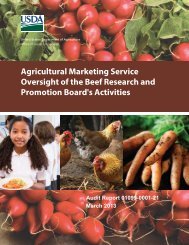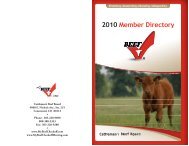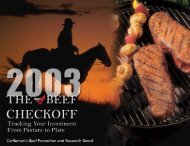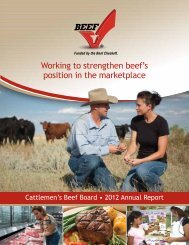National Market Cow and Bull Beef Quality Audit - Dairy Cattle Edition
National Market Cow and Bull Beef Quality Audit - Dairy Cattle Edition
National Market Cow and Bull Beef Quality Audit - Dairy Cattle Edition
- No tags were found...
Create successful ePaper yourself
Turn your PDF publications into a flip-book with our unique Google optimized e-Paper software.
Holding Pen <strong>Audit</strong>s – Part 2Key points:97% of the cattle had no evidence of cancer eye, animprovement over 1999 <strong>and</strong> 1994.<strong>Dairy</strong> cattle had more knots in the neck <strong>and</strong>shoulder than in beef cows, with more observedin the shoulder than the neck, an indication thatproducers need to observe labeling instructions forinjectable animal-health products.There was a higher incidence of lame dairy cows in2007 than in 1999 <strong>and</strong> 1994.Fewer cattle had light muscle scores than in 1999.More dairy cows were in leaner condition than in1999.Cancer eye -- 97% of all cattle had no evidence ofcancer eye. Cancer eye has been on a downward trendsince 1994, dropping from an incident rate of 8.5% in1994 to 4% in 1999 100<strong>and</strong> 3% in 2007.Visible knots – 92.1% of all cattle surveyed1994901999had no visible knots. When visible knots were present8020072.6% were in the neck, 4.6% in the shoulder, 0.2% inthe top butt, <strong>and</strong> 0.50% 7069in the 70 round. 85.8% of dairycows <strong>and</strong> 91.1% of dairy bulls had no sign 6160of knotsin the neck <strong>and</strong> shoulder. 4.3% of dairy cows <strong>and</strong> 511.5% of dairy bulls 50 had knots in the neck area. 8.8%of dairy cows <strong>and</strong> 6.7% 40 of dairy bulls had shoulderknots. The incidence of knots in the round area in dairy30cows decreased from 4.2% in 1999 to 0.7% in 2007.Incidence of knots 20 in the shoulder area of dairy cowsrose sharply from 0.6% 10 in 1999 to 8.8% in 2007.Frequency Distribution of <strong>Cattle</strong> withNo Evidence of Lameness Across all <strong>Audit</strong>s1009080706050403020100<strong>Dairy</strong> <strong>Cow</strong>s are More Lame than in 199969 70Frequency Distribution of <strong>Cattle</strong> withNo Evidence of Lameness Across all <strong>Audit</strong>s07761<strong>Dairy</strong> <strong>Cow</strong>s are More Lame than in 19995119941999200777767871All <strong>Cattle</strong> <strong>Dairy</strong> <strong>Cow</strong>s <strong>Dairy</strong> <strong>Bull</strong>s“The higher incidence of shoulder knots indicatesa need for continued education,” says Texas A&M’sDr. Jeff Savell. “These knots are likely the result ofintramuscular injections of animal health productsinstead of the recommended subcutaneous injectionsin the neck area.”Lameness – 70% of all cattle, 51% of dairy cows,<strong>and</strong> 78% of dairy bulls showed no sign of lameness.4% of all cattle received scores of 4 <strong>and</strong> 5, qualifyingthese animals as very disabled.At 49%, more dairy cows were lame in 2007 thanthe 39% in the 1999 audit <strong>and</strong> the 23% in the 1994audit.<strong>Dairy</strong> bull figures were slightly improved. In 200722% of dairy bulls were lame, compared to 29% in1999 <strong>and</strong> 24% in 1994.Muscling – 21% of all cattle audited wereinadequately muscled. There were fewer light-muscleddairy cows in 2007 than in 1999. In the 1999 audit72% of dairy cows came in with a muscle score of 1 or2. In 2007 that number fell to 35%,78 Body condition score – <strong>Dairy</strong> cattle were scoredfrom 71 1, severely emaciated, to 5,76All <strong>Cattle</strong> <strong>Dairy</strong> <strong>Cow</strong>s <strong>Dairy</strong> <strong>Bull</strong>sseverely over conditioned.63% of dairy cattle hadbody condition scores of 2.5<strong>and</strong> lower.100Point ofImprovementAdminister animal-healthproducts in the neck, <strong>and</strong>do so subcutaneouslywhen the label allows.<strong>Dairy</strong> <strong>Cattle</strong> <strong>Edition</strong> 790807060504030201006Frequency Distribution of Body ConditionScores for <strong>Dairy</strong> <strong>Cattle</strong>Approximately 63% of <strong>Dairy</strong> <strong>Cow</strong>s are BCS 2.5 <strong>and</strong> Lower2<strong>Dairy</strong> <strong>Cow</strong>s<strong>Dairy</strong> <strong>Bull</strong>s162Frequency Distribution of Body Condition1952210211 1.5 2 2.5 3 3.5 4 4.5 52311236252813


